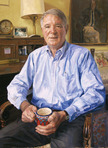William Peace's Blog, page 18
March 3, 2022
Review: The Boys in the Boat
I was given this book (a New York Times no. 1 bestseller) by one of my sons-in-law who rowed crew at university, but didn’t know that I had done some rowing, although I was never very good. In spite of the pain that one suffers when one is racing in an eight-man shell, it can be a truly addictive sport. And it can be very exciting for spectators cheering their boat, particularly during the last minute of a race.
This is an historic novel, and, paradoxically, quite suspenseful, written by Daniel James Brown. On his website he says: “I grew up in the San Francisco Bay Area and attended Diablo Valley College, the University of California at Berkeley, and UCLA. I taught writing at San Jose State University and Stanford before becoming a technical writer and editor. I now write narrative nonfiction books full time. My primary interest as a writer is in bringing compelling historical events to life as vividly and accurately as I can. I live in the country outside of Seattle, Washington with my wife, two daughters, and an assortment of cats, dogs, chickens, and honeybees. When I am not writing, I am likely to be birding, gardening, fly fishing, reading American history, or chasing bears away from the bee hives.”
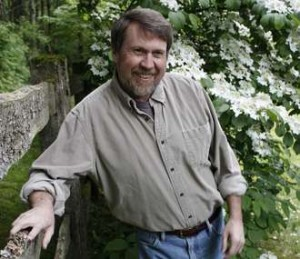 Daniel James Brown
Daniel James BrownThis book is about the eight-man (and a coxswain) crew from the University of Washington which won the Olympics in Nazi Germany in 1936. It is a true and memorable story, though almost none of us alive today have any memory of the event, and few ever heard the story. The central character is Joe Rantz, a poor, but tall and strong boy, who is beginning his freshman year at the University of Washington in the Depression of 1933. We learn about his checkered family background and his decision to row in an eight-man shell, of the difficulties he went through to win a place on the freshmen’s no. 1 boat. From that point, Joe struggles to win a seat on the junior varsity boat, the Washington varsity boat and the US Olympic boat, in all that time never losing a competitive race. The competition included the University of California crews and the best eastern crews: Penn, Navy, Cornell and Syracuse. There are plenty of obstacles that Joe and the rest of his crew have to overcome: financial worries, exhaustion, family relationship issues, training problems, and more. Each major race they face is clouded with uncertainty, but, since it’s a true story, we know in advance the real outcome, yet we live through the tension with Joe and his teammates. In Germany, for example, the final race seems to be stacked against the Americans: the Germans and and the Italians are given the two most favourable lanes; the Americans, the least favourable lane. Moreover, the American stroke (the stern-most oarsman who sets the pace) was ill.
Apart from the vivid writing and nearly constant tension maintained throughout, one has to marvel at the extensive and detailed research which the author had to do: interviewing Joe’s daughter, fellow crewmen, dozens of others and reading reams of records. Through it all, he is able to capture the magic that an eight-man crew can create when they are in the ‘swing’. There is plenty of captivating rowing folklore here. It’s a thoroughly enjoyable and interesting book.
February 27, 2022
Literature vs Generic Fiction: What’s the Difference?
The Reader Views blog of January 30, 2022, written by A J Smee, answers this question on four dimensions.
A. J. SMEE has been an international teacher for over twenty years, specializing in environment, languages, philosophy and design. He holds an advanced degree in Environmental Studies and an MA in Political Philosophy. His passion for learning and experience has carried him around the world, living and teaching in numerous countries in South America and Asia. He lives internationally with his wife and cats.
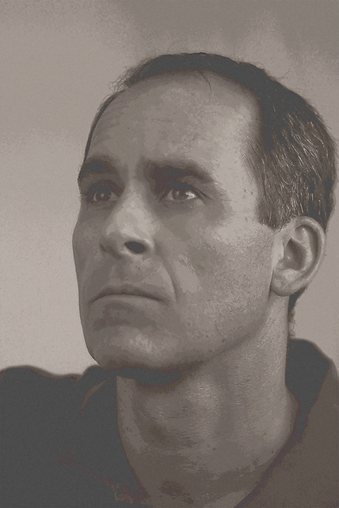 A J Smee
A J SmeeMr Smee says, “Understanding the underlying purpose of these two different genres is a starting point. Broadly speaking, genre fiction aims to entertain, and there is a technical toolbox that accompanies this type of popular fiction, which reaches into movies as well. But literary fiction probes deeply into our humanity, demanding more of both the author and the reader. What differentiates literary fiction from genre fiction can be summarised by four hierarchical points. As an author, if you write literary fiction or would like to venture into the genre, adhering to these targets will help you to penetrate the genre’s true depths.
Dealing with Social ConstructsIn some respect, good literature will contend with existing social constructs, economic, and social systems that we have created to help advance and establish social order. The caveat, of course, is how the protagonist fits into these systems and how these systems are failing her. The character’s confrontation with this world is what, in part, defines the actions of the protagonist; her response to the world is, in part what drives the story. Consider the social constructs that are most compelling to address and you’ll likely find a good literary story to write about.
2. The Human Condition
As the protagonist confronts the social situation, she is forced to discover the best and the worst of humanity. This may be evident from various sides. Antagonists that embody or advance the established systems often exhibit some element of human virtue that are most unbecoming, clashing with the protagonist’s ideals and forcing her to reconsider established beliefs. Out of this come actions and reactions that exhibit the behavioural tendencies of our humanity. Why we do what we do is a common thread that the reader is forced to consider in these literary stories.
3. Internal Struggle and Compromise
As stories in the literary genre are character driven as opposed to plot driven, much of the conflict should be centred around the internal struggles of the protagonist. Ostensibly, this leads the story and helps define it as literature. Committed to dealing with the conflict of the situation, the character must manage the internal frailties of her own moral and ethical fabric. How she comes to terms with her flaws or how she discovers aspects of herself that help her to overcome the conflict demonstrates the growth of the character. The depth of this character arc hinges of the authors ability to develop the internal conflict of the protagonist.
4. Style in Writing
To generalise, genre fiction is created to target specific audiences that would be most entertained by that type of writing and storytelling. Because of this, certain expectations about language, grammar and the story must be upheld. This constraint around the technique of storytelling in genre fiction has evolved mostly because of commercial factors; the author must comply with audience expectations. The literary genre has greater flexibility in this area, as the audience comes to applaud digressions from the norm if they are done effectively. This may include the complexity of language (although I don’t consider this a critical condition); a play with language that influences the effect on the reader; originality in exploring time, backstory and memory; or innovative ways to put the words on the page. And for the author, this can be liberating and creative in terms of how they choose to get their story across to the reader.”
“Whichever genre you prefer, some writing in the literary genre can prove to be an enlightening and useful endeavour. Not only can it aid in the author’s process of self-discovery, it hones an ability to write more complex characters, easily translating to other genres you write in. The literary genre most definitely presents other challenges to your writing, but some honest effort will surely improve your skill and technique as a writer.”
I think this is an excellent analysis.
February 19, 2022
How Many Pages in a Book?
In yesterday’s email, Harry Bingham of Jericho Writers discussed this question. Here are the excerpts of what he said.
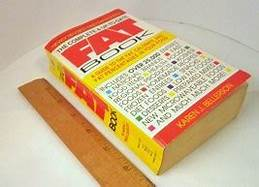 “The length of your manuscript matters. Partly, there’s just a crude commercial standard, varying somewhat by genre, as to how long a book needs to be. Subject to one major qualification (more on that later), the crude commercial standard is a thing of iron. You need to live within its constraints, or not be published.
“The length of your manuscript matters. Partly, there’s just a crude commercial standard, varying somewhat by genre, as to how long a book needs to be. Subject to one major qualification (more on that later), the crude commercial standard is a thing of iron. You need to live within its constraints, or not be published. “Let’s start with the Crude Commercial Standard. Every market for books has a set of largely standard prices. In the US, for example, a standard hardcover novel will retain at about $25. The same book with paper covers will sell at about $16-17. The cost of manufacturing a 200-page book is very largely the same as manufacturing a 400-page one. Most of the actual cost of the book lies in things like the author’s advance, the editorial process, the publicity and marketing, and so on, most of which are largely independent of length. That’s the main reason why price doesn’t vary much with quantity.
“But customers don’t think like that. If a customer notices that Someone Dies on a Train by Chris Agather is 400 pages long and selling for $25, they’ll resent paying the same price for the 200-page Someone Dies on a River by Aggie Christopher. Readers will buy the first book and ignore the second, while the latter’s publisher will learn not to put out a 200-page book.
“At this point, most actual readers will want to scream at me that some of their favourite books are very short. And OK, they are. But the customer hesitating between Someone Dies on a Train and Someone Dies on a River doesn’t know much about the quality of either book. The one certain piece of data is that the longer book will deliver more hours of reading than the shorter one – and for the same price. So (subject to the big qualification we’ll come to later) very short books don’t sell. They, mostly, aren’t even published.
“Following this logic, the Crude Commercial Standard therefore says that commercial novels need to be a minimum of 70 or 75,000 words to sell. Literary novels might start a bit smaller – say, 60,000 words or even 50,000. Nevertheless, the damn things need enough heft to satisfy the reader’s demand for value. The CCS doesn’t really have a firm upper end. There are sites on the internet which will tell you that 120,000 words is a hard upper limit, but it really, truly isn’t. My first book was more than 180,000 words long when it was published. The entire editorial process with HarperCollins didn’t shave more than a few thousand words from the original manuscript – and that shaving came mostly from me, not them.
“Likewise, epic fantasy fiction is meant to run long. Plenty of big historical fiction runs long. Plenty of thrillers run long. And of course, children’s and YA books run short. In every case, you just need to figure out how the CCS affects your particular market. OK. So much for the basics.
“The more Zen point is this. A professional reader – a Jericho editor, a skilled mentor, or a literary agent – will be able to read a synopsis and feel how long the book should be. Some stories feel like 80,000 words ones. Others feel like they need 120,000 words or more. I don’t pretend that this is an exact science, but it’s a real one all the same. I remember once reading a manuscript which was really good. A love story, with some extra trimmings, set in a great location, with good characters and some strong writing. That story should have been easy to sell. But it was 120,000 words long and the (fairly simple) story called for 80,000 words, or 90,000 tops. I told the author to delete text without removing content. That feels like a puzzling instruction – but I meant it literally. If you have five sentences of description about (say) a Victorian horse-market, you will almost certainly find that you can convey all the relevant atmosphere in three. If you have four paragraphs describing a rail journey from Vienna to Trieste, you can probably handle that in one or two. Authors who tend towards the prolix will also find that an eighteen-word sentence can be reduced to twelve without actually saying anything materially different. The mantra has to be, “Reduce length, maintain content”. If you do that, you’ll find you actually enhance your content, because you’ll be deleting the least effective words / sentences / paragraphs, so the impact of what’s left will be all the greater.
“(I should also say that although it’s much more common for people to need to cut their work, it can operate the other way round as well. Sometimes a writer delivers a book that’s fine – just too short. Journalists in particular, trained in being sparing and factual, can be guilty of this. The trick here, once you’ve recognised the issue, is to figure out where the book is missing. It’s often textural stuff: descriptions of place, of feeling, of character nuance.)
“The author of that 120,000 word book struggled at first to do what I’d asked. The manuscript came back with maybe 2,000 words shaved off it, then – after I’d yelled at her again – another 5,000 words. It was only after the book went out to agents (and secured plenty of interest, but no firm offers of representation) that the writer sat down and really properly addressed what I’d asked her to do originally. The book came down to well below 100,000 words, and it wasn’t just shorter. It was denser, it was better, it was richer, it was more alive. That book secured an agent and, subsequently, a book deal. It deserved to. The book had found its proper weight and, at its proper weight, sold easily. Oh yes, and the one big qualification when it comes to the Crude Commercial Standard? Simple. The better the book, the less the CCS matters. If you are an author of genius, then write whatever the heck you want. The market will find a way to sell it. “
This seems to me a very useful discussion of how long a manuscript should be.
February 12, 2022
The Book Tok Phenomenon
The February 1 issue of the Daily Telegraph carried an article by Anita Singh under the title “‘Book Tok’ inspires young readers to get reading.”
Muck Rack says that Anita Singh is “Daily Telegraph arts and entertainment editor. TV critic. Bradfordian. “
Ms Singh writes, “The rise of Book Tok is driving teenagers and young adults into bookshops in numbers not seen since the Harry Potter years, according to the head of Waterstones. Sales are booming after being recommended by influencers on Tik Tok, the social media app – but some classics are also becoming unlikely viral sensations. ‘These last three or four weeks in the United States, James Joyce’s Ulysses had been a significant seller because on Tik Tok, the kids are getting excited about it,’ said James Daunt, managing director of Waterstones and chief executive of the US chain Barnes & Noble.

“The #BookTok has tag has had 37.4 billion views and popular influencers tend to be young women, mostly recommending books by female authors. Mr Daunt said they were helping to make bookshops popular with young people, reminding him of the decade 1997-2007 which saw publication of J K Rowling’s Harry Potter series. ‘It’s back to that kind of energy in our stores. Our challenge now is that we absolutely have to keep those customers, as we did with the Harry Potter generation. It stepped booksellers up and it stepped book sales up,’ Mr Daunt told a bookselling conference in Italy.
“Waterstones runs its own Tik Tok account as a marketing tool, and Mr Daunt explained: ‘It’s about fun and enjoyment and enthusiasm and the people doing it brilliantly are of the same generation – it’s our young booksellers, and we let them get on with it.’ He joked: ‘We have generally found that the people with blue hair do better than the people with sensible haircuts.’
“Barnes & Noble has dedicated a section of its website to books recommended on Tick Tok. Even W H Smith groups some of its books under the tag ‘Tik Tok made me buy it.’
“The New York Times reported on the phenomenon with the headline ‘How Crying on Tik Tok sells books, noting that tear-jerking novels were particularly popular.
“One of the most popular British ‘Book Tok’ stars is 22-year-old Abby Parker, who has amassed 428,000 followers. She told Amazon last year: ‘I’ve always dreamed of sharing my love for books with the world and Tik Tok has finally been my gateway into doing just that. Getting completely involved with the book community this past year has been truly one of the greatest things I’ve done in my life.'”
I think we should congratulate Abby and her colleagues for spreading her book enthusiasm to young people.
February 5, 2022
Modern Despair with Dostoevsky
There is an article in the Daily Telegraph on 30 January this year by Craig Simpson with the title: “Prophet of Despair Dostoevsky hits a nerve with readers in ‘irrational, egoistic’ times”.
Craig Simpson reports on arts and entertainment for the Telegraph.
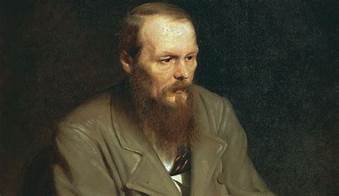 Fyodor Dostoevsky
Fyodor Dostoevsky“Fyodor Dostoevsky wrote of ‘the pleasure of despair’, and book sales reveal British readers are buying into his brand of agreeable anguish. The Russian existentialist oeuvre is the fastest growing market for Penguin Classics, ahead of more genteel favourites like Austen and Dickens, with sales of his novels doubling in five years.
“Sales of Crime and Punishment and Notes from the Underground have quadrupled, propelling Dostoevsky from close to 40th on the list of bestselling classics authors to number 4. While the clamour for the 19th-century author’s ‘gloom and nihilism’ is ‘mysterious’ to publishers, experts suggest that pessimistic modern readers have found a ‘prophet’ in him.
“Kevin Birmingham, author of literary biography The Sinner and the Saint, said: ‘The appeal is that Dostoevsky’s view of human nature seems more apparent now: we’re irrational, egotistic and self-destructive. We spite ourselves, we crave freedom even if it leads to our detriment, and our perverse impulses are at the heart of civilisation. Readers of Dostoevsky’s novels would not be surprised by global affairs over the last several years. These are all Dostoevskian. There is an abiding fear that there are no foundations. no ultimate sense of truth or justice, and this is something we’re grappling with these days. No doubt there’s another era of optimism and confidence on the horizon, and Dostoevsky won’t fit so well with that.’
“He is currently fitting very well with the mood of readers, according to the Penguin Classics team, and an increasing audience for angst which has seen sales for the author’s works increasing 177 percent since 2016. His life experiences, Russian Orthodox beliefs, and insights on irrational human behaviour fed into works from Poor Folk to The Brothers Karamazov before his death in 1881. The renewed appeal of his intense novels led to a 60 percent sales growth for Penguin Classics in 2021 alone.”
If Dostoevsky is up, dystopian novels should also be booming!
January 28, 2022
Behind The Great Gatsby
Sean Smith has an article in the October 16, last year, copy of The Independent which describes how F Scott Fitzgerald’s personality and life experiences defined the plot and the characters in The Great Gasby.
Sean Smith is a writer and freelance journalist who specialises in op-eds and features on a wide variety of subjects. I have abbreviated his article as follows:
“Gifted, charismatic and impoverished, F Scott Fitzgerald fell hopelessly in love with rich socialite Ginevra King while still an undergraduate at Princeton. When the affair inevitably failed, her father was quick to admonish the aspiring writer. “Poor boys shouldn’t think of marrying rich girls.” Had he heeded that advice, Fitzgerald may well have led a longer and happier life but he wouldn’t have gone on to write the greatest novel of the 20th century.
Although he was desperate to break into the inner circle of the Waspish, protestant elite, Fitzgerald’s limited means and Irish Catholic roots would cast him as a perennial outsider or “a poor boy in a rich town; a poor boy in a rich man’s school; a poor boy in a rich man’s club at Princeton,” as he later acknowledged. But his sense of exclusion would also provide his motivation and subject matter: “I have never been able to forgive the rich for being rich and it has coloured my entire life and work.”
After being rejected by Ginevra, a heartbroken, Fitzgerald dropped out of college and joined the army in the vain hope of seeing action overseas before the end of the war. As a young officer, Fitzgerald was stationed at Camp Sheridan in Alabama in March 1918 for basic training. History looked set to repeat itself when he unwisely became infatuated with wealthy southern belle Zelda Sayre, who could take her pick from the wealthy young officers who flocked to her family porch.
But Fitzgerald became her most persistent gentleman caller and he would later use the courtship as a model for Gatsby’s youthful pursuit of Daisy. The rule that officers had to wear uniforms at all times, even while socialising, meant that he could disguise the extent of his threadbare poverty from Zelda. Gatsby later benefits from the same “invisibility cloak” with Daisy.
After being demobbed from the army in February 1919, Fitzgerald proposed to Zelda, who made it clear that she had no intention of being poor: “I’d just hate to live a sordid colourless existence.” In the novel, Daisy dispatches Gatsby less brutally but ostensibly for the same reason.
For Fitzgerald it was far from plain sailing. Having failed to secure a writing job with every newspaper in New York, Fitzgerald eventually settled for an advertising role which paid just $90 a week, hardly enough to think of marrying a girl like Zelda.
In the evenings, Fitzgerald wrote short stories with limited success. When Zelda rebuffed a further proposal in June, Fitzgerald fell into despair and a month-long drinking bender only paused by the introduction of prohibition on 1 July 1919.
Depressed to the point of suicide, Fitzgerald resigned his job returning to his midwest family home in St Paul, Minnesota, to rework a previously rejected manuscript into a new novel called This Side of Paradise, which he sent to a publisher more in hope than expectation. When they wrote back with their intention to publish, everything changed.
Zelda, delighted that the sudden prospect of fame and fortune pushed Fitzgerald through the threshold of eligibility, accepted his new proposal with brutal pragmatism. “I hate to say this but I don’t think I had much confidence in you at first. It’s so nice to know you can really do things.”
This Side of Paradise was an overnight sensation that would make Fitzgerald the prince and chronicler of the jazz age. But Fitzgerald never forgot or forgave the terms of Zelda’s conditional acceptance and confided in friends that he was struggling to recapture the thrill of their initial courtship.
But in private, their alcohol-fuelled rows convinced friends that their marriage would be short-lived. Friends also noticed how theit celebrity lifestyle and Zelda’s expensive tastes made it difficult for Fitzgerald to find the time, space and sobriety to produce work of any real substance.
Fitzgerald was running up huge debts paying for hotels, jewellery, travel and extravagant parties, which he financed by churning out short stories for magazines. Financially, he seemed to be constantly running just to standstill.
Novels were lengthy investments of time and effort with no guarantee of financial success but commercial short stories were a sure thing that kept his creditors at arm’s length.
Fitzgerald quickly came to resent cranking out light and frothy dross to a prescribed formula: “I’ve made half a dozen starts yesterday and today and I’ll go mad if I have to do another debutante which is what they want.”
In contrast, the extravagant Zelda welcomed the lucrative fees offered by the magazines although she later acknowledged the strain it placed on their relationship. “I always felt a story for the [Saturday Evening] Post was tops, a goal worth seeking. It really meant something you know – they only took stories of real craftmanship but Scott couldn’t stand to write them.
The Great Gatsby’s recurring theme of selling your soul for financial remuneration was beginning to stir in Fitzgerald’s imagination. Exactly a century ago when their only daughter Frances was born, F Scott Fitzgerald was struck by his wife’s welcoming words: “I’m glad it’s a girl. And I’ll hope she’ll be a fool. That’s the best thing a girl can be in this world, a beautiful little fool.” Three years later, he lifted them verbatim into the mouth of Daisy Buchannan in The Great Gatsby.
Fitzgerald felt helpless and resented the way his living costs limited the quality of the work he could attempt. “I can’t reduce our scale of living and I can’t stand this financial insecurity. I had my chance in 1920 to start my life on a sensible scale and I lost it and so I’ll have to pay the penalty. Then perhaps at 40 I can start writing again without constant worry and interruption.”
In September 1922, the Fitzgeralds moved to Great Neck in Long Island to be close to New York, where Fitzgerald’s disastrous first play, Vegetable,was being staged.
Its failure incurred enormous costs and Fitzgerald was forced to clear his debts by producing magazine short stories on an industrial scale, writing for 12 hours without a break and creating entire tales in a single sitting. He confided in a friend: “I really worked hard as hell last winter – but it was all trash and it nearly broke my heart as well as my iron constitution.”)
And yet somehow throughout this period Scott and Zelda were still partying hard, spending a staggering $36,000. The parties at Great Neck were to furnish Fitzgerald with much of the raw material for The Great Gatsby and the fictional setting of West Egg – the suburban stepping stone for those aspiring to join the establishment elite in East Egg.
But the decadence was unsustainable. Indebted and exhausted, the Fitzgeralds decamped to France to take advantage of the advantageous exchange rate and to finally give Scott Fitzgerald the time and space to write the serious novel he’d been craving to tackle for so long.
Zelda’s hackles were raised because she could sense that she had become the inspiration for a cautionary tale of idealism corrupted by materialistic greed: “Scott has started a new novel and retired into strict seclusion and celibacy. He’s horribly intent on it and has built up a beautiful legend about himself which corresponds somewhat to the old fable about the ant and the grasshopper. Me being the grasshopper.”
Perhaps that resentment fuelled her affair with French aviator Edouard Josanne in July 1924 while Scott was working on a first draft of The Great Gatsby. The affair was undoubtedly a traumatic turning point which Scott later acknowledged. “That September, I knew something had happened that could never be repaired.”
Fitzgerald even stopped drinking and experiencing what alcoholics call a moment of lucidity, redrafted the relationship between Gatsby, Daisy and Tom Buchannan into sharper focus. The character of Daisy is drawn in a new light – part Ginevra and Zelda, utterly charming but profoundly insincere – capable of capturing the heart of a naïve young man but completely unworthy of a wiser man’s love.
Although Daisy is infatuated by Gatsby, just as Zelda was smitten by Fitzgerald it becomes clear that her true soul mate is the establishment itself, personified by her entitled and arrogant husband Tom Buchannan.
Fitzgerald casts Gatsby as a surrogate for himself – an idealistic and innocent bystander destroyed by his inability to truly understand the rich and their selfish instinct for self preservation .
Drawing on his own personal experience, Fitzgerald specialises in drawing characters who yearn to break into the ranks of the rich and powerful. Through his vivid depiction of the Wilsons, the unhappily married couple who run the gas station in Ash Valley, Fitzgerald captures the sense of life literally passing them by.
By 1925, Fitzgerald could already sense that there wasn’t going to be a fairy tale ending. The brevity of The Great Gatsby suggests a genius writing at full gallop, making the most of his moment of lucidity to produce his masterpiece before succumbing to the financial allure of Hollywood and his rapid descent into alcoholism.”

Not many writers have a life as emotionally riven and torn as Scott Fitzgerald’s, but he poured all of his feelings, observations and experiences into a great novel.
January 23, 2022
Manuscript Thefts
An article with the title ‘Hunt for the Book Thief in a literary Whodunnit’ by Anita Singh appeared in the 7 January 2022 issue of The Daily Telegraph.
“It was a mystery which gripped the publishing world: who was the secret fraudster behind a scheme to steal unpublished manuscripts? The scammer targeted hundreds of victims by assuming the identities of editors, agents and literary scouts in a global fraud spanning five years. On Wednesday, the FBI announced it had arrested and charged a suspect – Filippo Bernardini, 29, who had a lowly job in the rights department of the London office of Simon & Schuster.
 Filippo Bernardini
Filippo Bernardini“While it had long been suspected that the culprit had links to the publishing industry – they used familiar abbreviations such as ‘ms’ for ‘manuscript’ – the arrest came as a shock. Some of those targeted had dealt with Mr Bernardini on a professional basis. Mr Bernardini, an Italian citizen who studied for a masters degree in publishing at University College London, was arrested at New York’s John F Kennedy Airport. He is charged with wire fraud and aggravated identity theft. Prosecutors allege the Mr Bernardini impersonated, defrauded and attempted to defraud hundreds of individuals. The indictment did not mention the manuscripts in question. However authors who have been targeted by such a scam over the last five years include two of the world’s bestselling novelists – Margaret Atwood and Jo Nesbo and their books The Testaments and Knife – and at least one Pulitzer Prize winner.
“The charges allege that between 2016 and July last year, Mr Bernardini ‘engaged in a scheme to fraudulently obtain valuable prepublication manuscripts of novels and other forthcoming books, as well as synopses and other notes and reports related to unpublished books.’ He allegedly did this by creating lookalike email addresses – for example, replacing the letter ‘m’ in penguinrandomhouse.com with ‘rn’, a tiny, easily overlooked adjustment. According to prosecutors, Mr Benardini registered more than 160 fraudulent internet domains. All would forward to a single email address that he controlled.
The Indictment says Mr Bernardini devised the scheme to obtain ‘money and property by means of false and fraudulent pretenses’. However the motive is obscure, as some of those targeted were little-known novelists. No ransom demands were made, and the manuscripts were never pirated. . . . Michael J Driscoll, of the FBI, said ‘he was allegedly trying to steal others’ literary ideas for himself.'”
It seems to me that Mr Bernardini was indeed trying to steal others’ literary ideas for himself, as he made no apparent attempt to monetise the information he obtained. We authors must be careful in our correspondence with publishers, agents and literary scouts. And the industry needs to tighten its internal controls.
January 14, 2022
Review: It Can’t Happen Here
This novel by Sinclair Lewis caught my eye at the 30th Street Station in Philadelphia when I was in the States visiting family for Thanksgiving. It was published in 1935 when the US was still in the valley of the Great Depression, and parts of Europe were in the grip of fascism. In his introduction to the book, Michael Meyer, Professor of History at the University of Connecticut, says, “Engulfed by the complexities and vulnerabilities of our post-September 11 world, Americans of nearly all political persuasions are likely to find that It Can’t Happen Here, though firmly anchored in the politics of the 1930s, surfaces as a revealing and disturbing read.”
Harry Sinclair Lewis was born in 1885 in Minnesota. He attended Yale where he was editor of the literary magazine. After graduation in1907, he worked as a reporter and editor of various magazines, newspapers and publishing houses. His first novel, Our Mr Wrenn, was published in 1914, but his first successful novel, Main Street was published in 1920. He won the Pulitzer Prize for Arrowsmith in 1925. In 1930 he became the first American writer to win the Nobel Prize for Literature. He died in 1951.
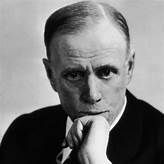 Sinclair Lewis
Sinclair LewisIt Can’t Happen Here is more a political commentary than a novel. Set in the mid-1930s it describes how the political climate at the time results in a fascist government taking power in the United States. It is all seen through the eyes of Doremus Jessup, the editor and publisher of a local newspaper in Vermont. Senator Buzz Windrip is elected President, having promised to restore American prominence in the world while providing $5000 per year for each American citizen. Dissent is outlawed by the new Corpo (short for corporate) regime, the American Congress is neutralised, power is removed from the states and given to new, autocratically-run districts. Women are disenfranchised; a. powerful new, savage militia known at the Minute Men is created, justice is administered by military tribunals, dissidents are imprisoned in concentration camps or executed. Doremus joins the New Underground resistance movement, secretly publishing the truth of what is happening. He is imprisoned, is tortured, escapes to Canada, and is assigned the territory of Minnesota to encourage resistance to the Corpos, who have started a diversionary war with Mexico, as the country descends into civil war.
At a personal level, viewed either from a liberal or an authoritarian position, the story has credibility. A gardener becomes a high-ranking Minute Man, with life and death power over his former employer. The motivations and emotions on each side are clear. The book is filled with minor characters, right- and left-leaning, filling many different positions at local, district and national levels, adding credibility to what is happening. The tone of the book is largely neutral: atrocities are reported factually, so that it is not a grand polemic, but a sober report. There are elements of satire and humour in the descriptions of some events, which make it clear whose side the author is on, while preserving his credibility.
The book is a sobering attention-getter without suggesting an action plan. Lewis was not a political thinker; he was an independent liberal who believed in individual rights. He was a reporter of what he saw and could foresee.
It seems unlikely that even with the concerted efforts of group of powerful fanatics America could become fascist as easily as it did in It Can’t Happen Here. It would not be easy to overcome the democratic forces exerted by an aroused US Congress, the US judiciary and the armed forces. But given what happened on January 6 2021, one has to pause for thought.
January 6, 2022
One-Hit Wonders
The Sunday Telegraph had an article about authors who wrote one brilliant novel and never published another. The article is written by Claire Allfree, who is a freelance writer covering arts and entertainment in the UK. I quote from her article below.
“When the New Zealand novelist Keri Hulme died last week at the age of 74, she joined a venerated group of authors not known for winning the Booker Prize – which she did in 1985 with her Maori magic realistic epic The Bone People – but for the production in her lifetime of only one complete novel. Emily Bronte, Margaret Mitchell, J D Salinger, Ralph Ellison, Harper Lee, Anna Sewell all wrote a single, game-changing, long-form masterpiece. To that list can be added novelists equally or better known for other art forms – the poets Sylvia Plath and Boris Pasternak; the playwright Oscar Wilde; the short story writers Alice Munro and Edgar Allen Poe, although Bronte was also a n accomplished poet and Salinger a revolutionary short story writer. Nonetheless the image of the artist who produces just one perfect piece of work and then lapses into silence, often out of sight of the public view, is seductive. How admirable to leave just a single artistic legacy, its brilliance undimmed by inferior additional works, untainted by the siren call of game or ego.”
“Seductive, but rarely true. Few writers calmly put down their pen after dashing off a fabulous big hit, with the possible exception of Margaret Mitchell, whose Pulitzer Prize-winning Gone with the Wind was published in 1936. Mitchell always insisted she would never write another book, partly out of horror at her new-found celebrity (she expected Gone with the Wind to sell 5000 copies; it sold 50,000 on its first day). But while she refused all interviews, there were rumours she was considering a second, when she was killed in 1949 by a drunk driver at the age of 48.
The writer who comes first to my mind in this category is Harper Lee, whose novel, To Kill a Mockingbird is an American classic. “Lee never wrote another book after To Kill a Mockingbird was published in 1960, but possibly not for want of trying. ‘Success has had a very bad affect on me,’ she later said. ‘I’ve gotten fat – but extremely uncomplacent. I’m running just as scared as before’. “
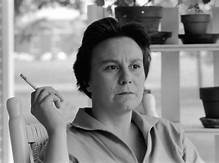 Harper Lee
Harper LeeHarper Lee’s book, Go Set a Watchman, which was published in 2015, has confirmed to be an early draft of Mockingbird. In my opinion it was not even close to the calibre of Mockingbird.
“No, the messier, more complicated truth would appear to be: once a writer, always a writer. Some radical figures like Hulme, Salinger, Mitchell and Lee do not necessarily believe that everything they write needs to be published, or that writing – that most solitary of forms – should be considered a public spectacle.”
“In fact Hulme, who when told by telephone that she had won the Booker replied, ‘Oh, bloody hell’, rejected the idea that her writing was for the benefit of other people. A pipe-smoking, white-baiting aficionado who lived alone in a small settlement on New Zealand’s south island, in a house she built herself. Hulme embraced a maverick obscurity, yet she continued to write after her win, producing short stories and two further manuscripts that remained unpublished at her death. ‘It might seem that I’m low in the productive stakes. I don’t think it’s about being a celebrity at all. It’s about creating stories and songs that will last. Otherwise, it’s not worthwhile.”
“Meanwhile Salinger, who in 1953 retreated to a house in New Hampshire where he remained virtually unseen until his death in 2010 following the zeitgeist-defining of 1951’s The Catcher in the Rye told the New York Times in a rare 1974 interview that, ‘There is a marvelous peace in not publishing. It’s peaceful. Still. Publishing is a terrible invasion of my privacy.’ All the same. rumours abound over what manuscripts may be gathering dust: in that same interview he said he continued to write ten hours a day, while his daughter Maureen has spoken of a vault filled with rigorous notes on what was to be published after his death. Nothing has so far materialised, with Salinger’s son and widow, who control his estate, as tightlipped and suspicious of public scrutiny and the publishing machine as Salinger was.”
I remember reading The Catcher in the Rye in 1955 when I was in high school in New Hampshire. At the time is was suggested reading for the senior class.
Ms Allfree goes on to say that “Salinger, Mitchell and Lee all attempted to exert absolute control over their writing, pursuing unscrupulous publishers who tried to produce unlicensed editions of their work.”
This kind of conflict ultimately benefits no one.
December 31, 2021
Multiple Narrative Forms
Writer’ Digest has an article by Liz Keller Whitehurst, dated 9 November 2012, in which she describes the advantages of using multiple narrative forms, including first and third person narratives, interview transcripts, letters, posts, and journal entries.
Ms Whitehurst is the author of her debut novel, Messenger, and her short stories have appeared in many literary magazines and journals. She earned master’s degree in English from The University of Virginia. In addition to fiction writing, Liz has spent her professional life writing and teaching. She lives with her husband in Richmond, Virginia.

Liz Keller Whitehurst
Ms Whitehurst says, “My novel tells the story of Messenger, a mysterious older woman who delivers life-changing messages to seemingly random people all over New York City; and Alana, the young journalist who longs to tell Messenger’s story. The use of multiple narrative forms embodies Alana’s journey as she, a sort of detective, seeks to gather information and first-person accounts, to search for clues. Her goal is to track Messenger down, meet and get to know her, then hopefully unravel her mysterious messages and to determine if this story is the big break that will make Alana’s career.
“Being a writer, it’s natural that Alana would keep a journal and would ask Messenger to write down her own thoughts, to explain her process, and to reveal more about herself. The posts Alana receives from people whose lives were changed by Messenger’s messages also works naturally, as do the interview transcripts. And the quick rhythm of switching back and forth between forms mirrors the fast-paced life of one of the other main characters of the novel—New York City.
“Using multiple forms with multiple characters and thus, dividing the novel into shorter sections or bites is a means of addressing readers’ short attention span and the way we tend to read on our computer and phones these days. Just as short stories have seen a new resurgence, these shorter pieces encompass the clarity of that life-changing moment like flash fiction, and can be read in a short period of time and still satisfy.
“I love it when I, the reader, know more than the characters I’m reading about. It’s delicious, builds tension, and moves the dramatic arc along with verve. Creating dramatic irony is another plus of using multiple narrative forms. In my novel, I wanted the reader to know much more about Messenger and the Watchers than Alana has any idea of, both through the action but also through what Messenger reveals in Messenger’s Composition Book. Through Messenger’s entries, the reader gets a glimpse of the greater aim behind Messenger and Alana’s journey together, far beyond the book Alana thinks she’s writing.
“The editor, publisher, and I had fun choosing just the right fonts for each of the narrative forms, so that Alana’s Journal, Messenger’s Composition Book, the posts, and the traditional narrative chapters each had its own particular font to distinguish them from one another. Using different fonts makes the book more visually appealing and easier to follow as it shifts forms.”
I would add that using multiple narrative forms with multiple characters gives the writer the advantage of several sources of information to develop each individual. One can use different sources offering divergent view of a character, so that the reader gets an in-depth view of a complex person.

